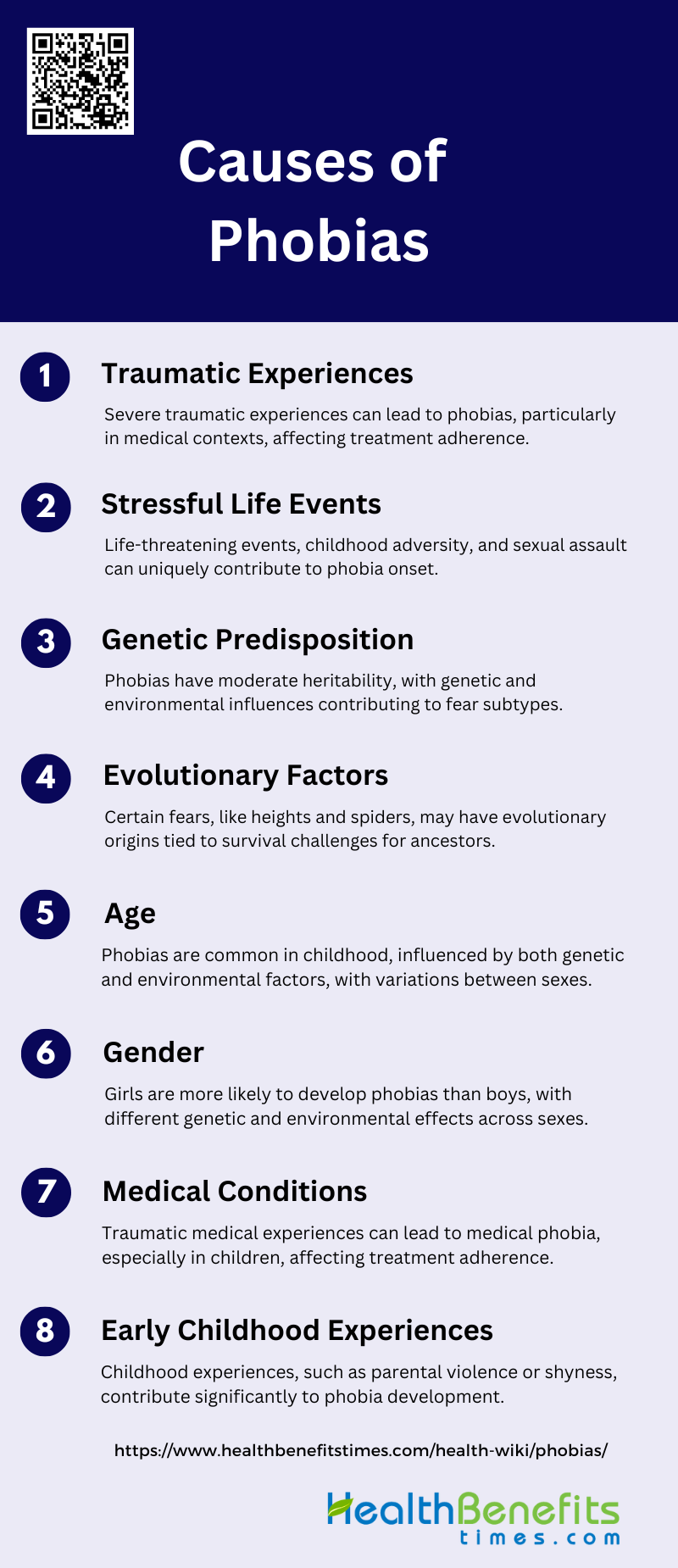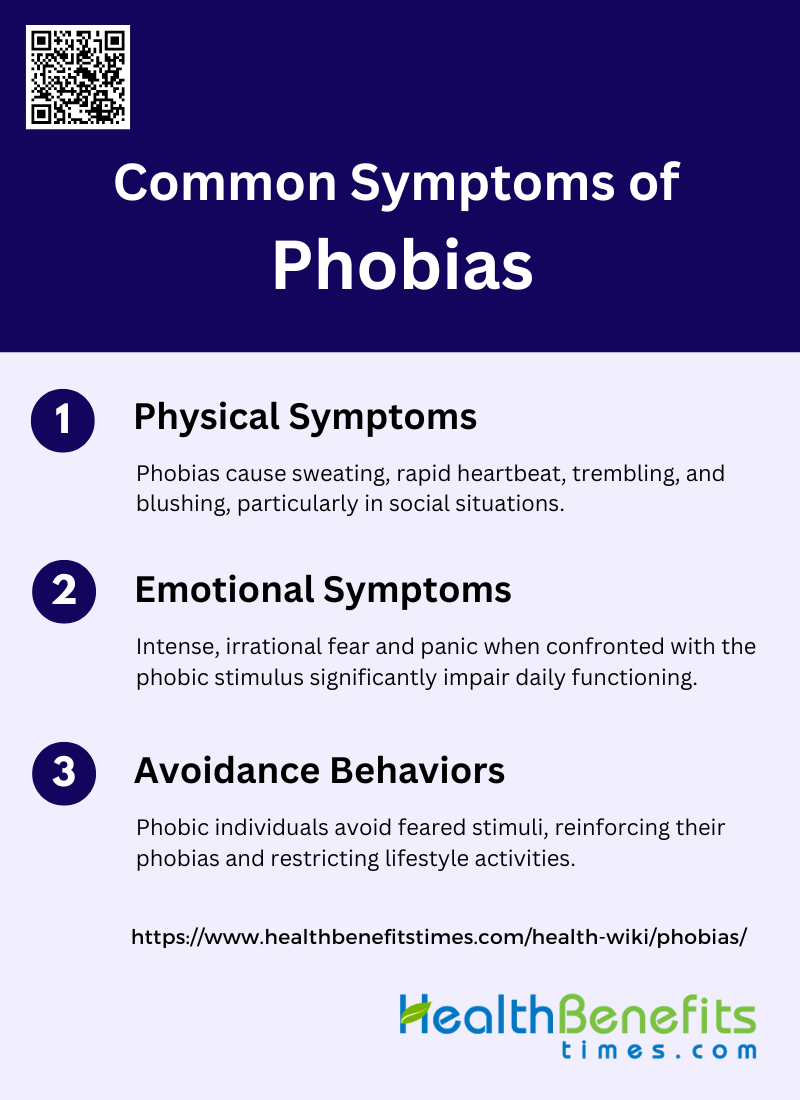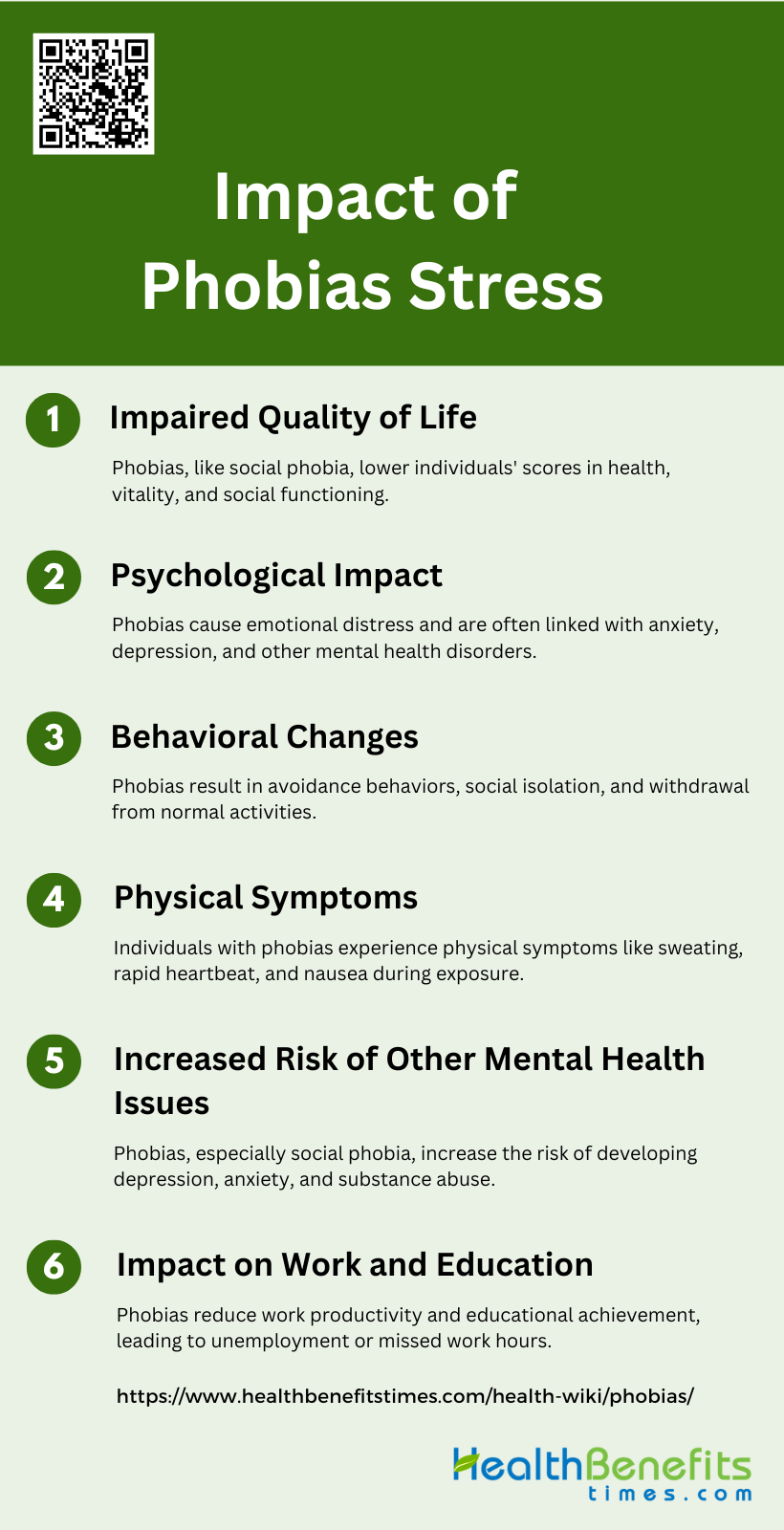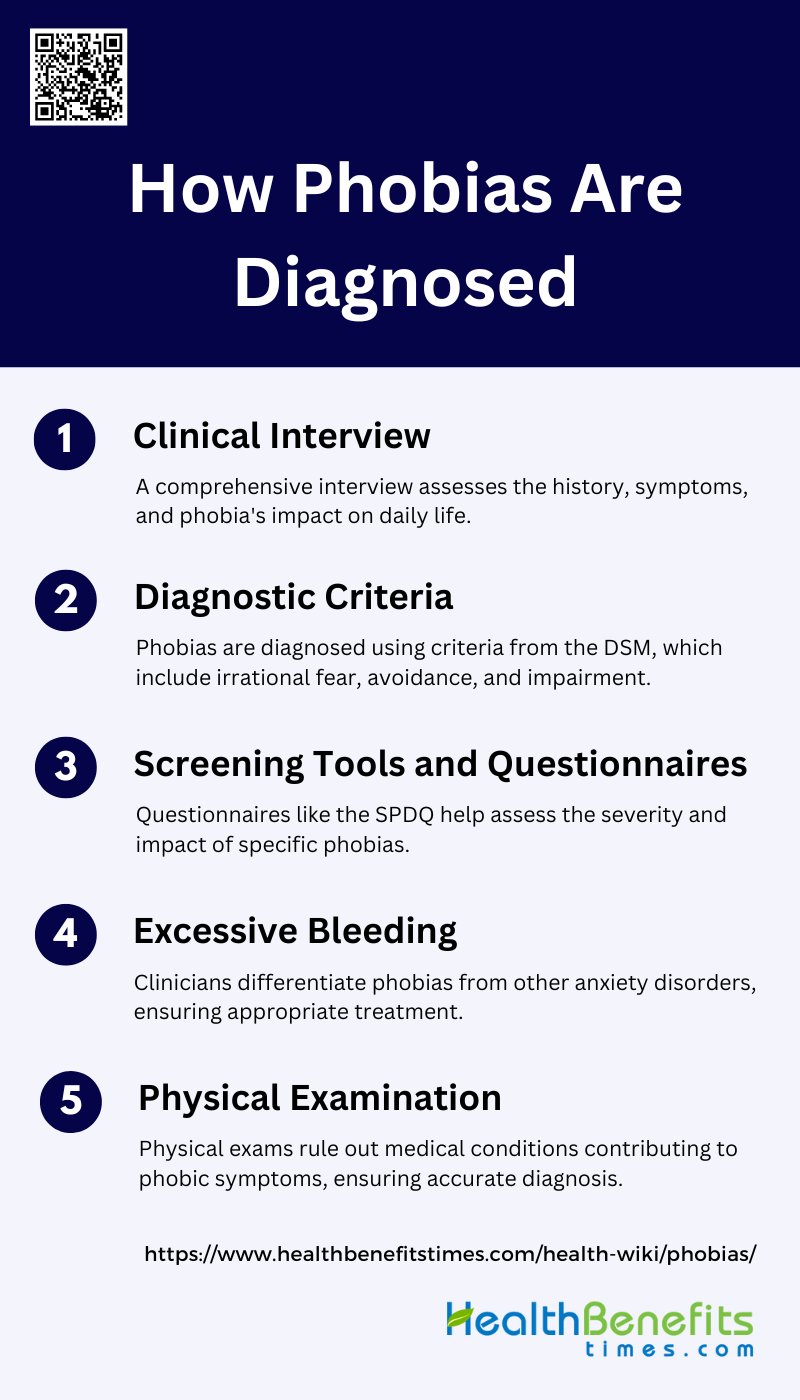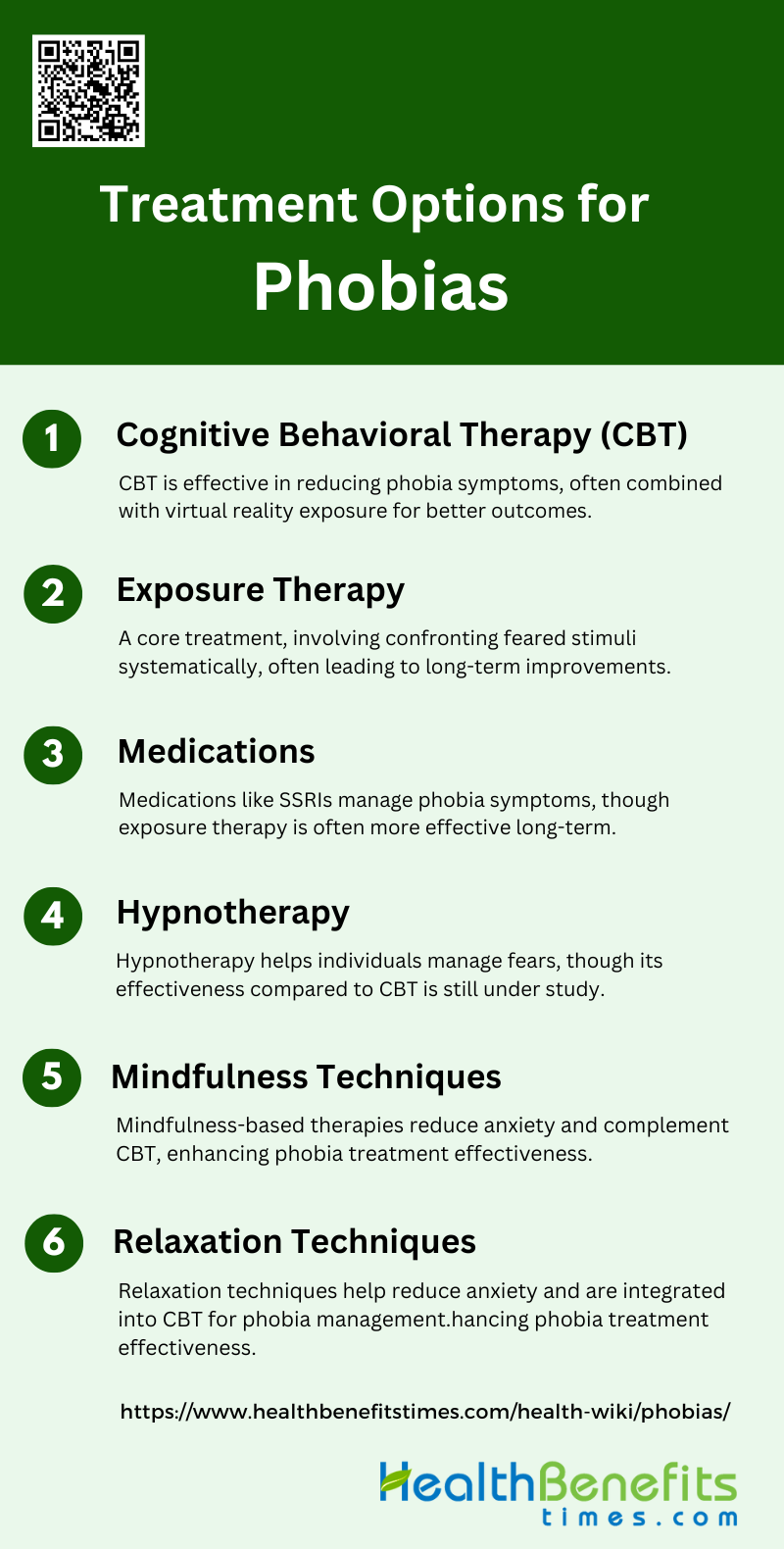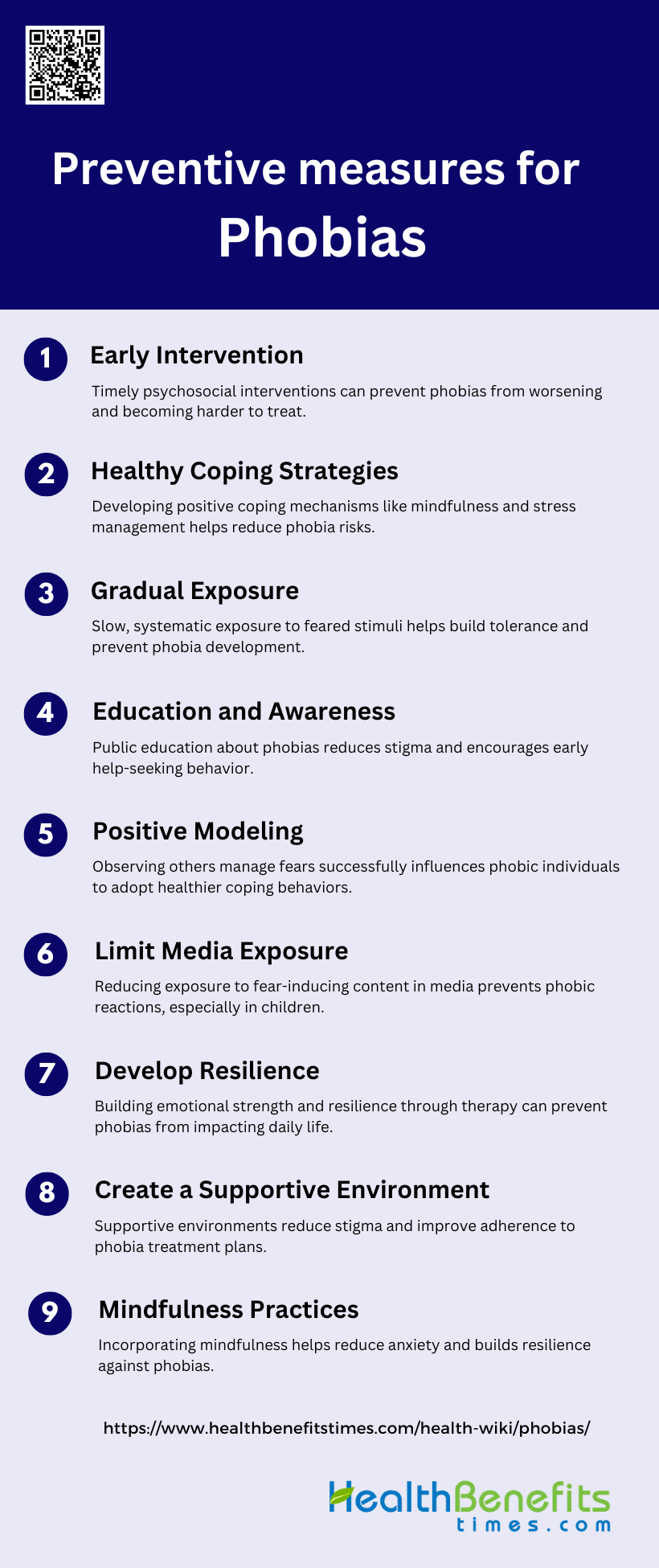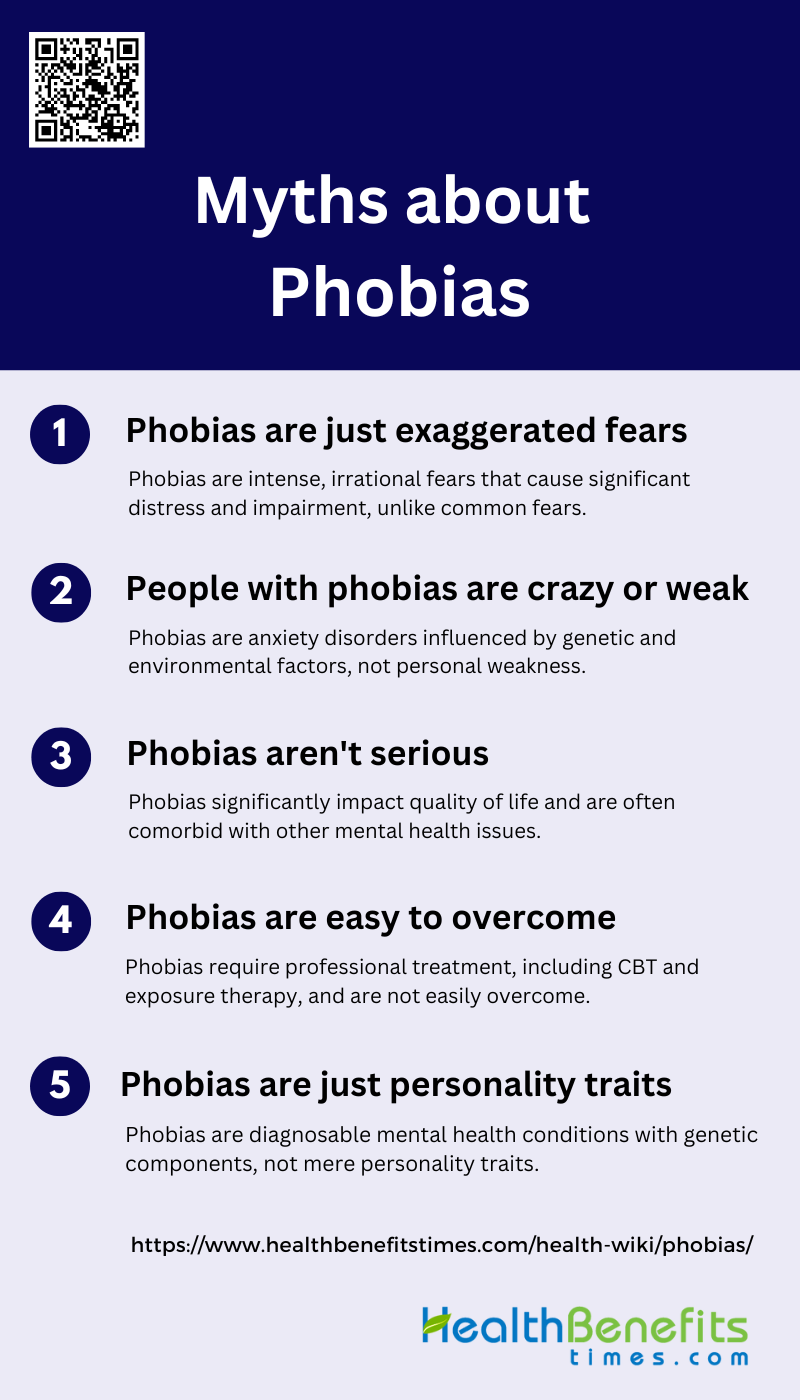Phobias are intense, irrational fears of specific objects, situations, or activities that pose little or no actual danger. They are classified as anxiety disorders and can cause significant distress and impairment in a person’s daily life. Common phobias include fear of heights (acrophobia), fear of spiders (arachnophobia), and fear of enclosed spaces (claustrophobia). When exposed to the feared stimulus, individuals with phobias may experience symptoms such as rapid heartbeat, sweating, trembling, and a strong desire to escape the situation. Phobias often develop in childhood or adolescence, but they can also emerge in adulthood. While the exact causes are not fully understood, factors such as genetics, traumatic experiences, and learned behaviors may contribute to their development. Treatment options for phobias typically include cognitive-behavioral therapy, exposure therapy, and in some cases, medication to manage anxiety symptoms.
Types of Phobias
Phobias are intense, irrational fears of specific objects or situations that can significantly impact an individual’s daily life. These fears often lead to avoidance behavior and can cause considerable distress. Below is a list of common phobias, each with its unique characteristics and challenges.
1. Arachnophobia
Arachnophobia is one of the most common specific phobias, characterized by an intense fear of spiders. Studies have shown that movement-related characteristics of spiders are particularly frightening to individuals with this phobia, and exposure therapy, including augmented reality applications, has been effective in reducing symptoms. Shortened versions of the Spider Questionnaire (SPQ) have been developed to efficiently assess the severity of this phobia.
2. Cynophobia
Cynophobia, or the fear of dogs, is less frequently studied compared to other animal phobias like arachnophobia and ophidiophobia. However, it falls under the broader category of animal phobias, which are prevalent and often more intense in younger individuals.
3. Ophidiophobia
Ophidiophobia, the fear of snakes, is another common animal phobia. Similar to arachnophobia, it is often assessed using specific questionnaires like the Snake Questionnaire (SNAQ). Studies indicate that fear and disgust are significant emotional responses elicited by snakes, and these emotions play a crucial role in the onset and maintenance of the phobia.
4. Acrophobia
Acrophobia, or the fear of heights, is one of the most prevalent specific phobias, particularly among men. It is classified under situational phobias and has a high prevalence rate, often leading to significant impairment and comorbidity with other psychiatric disorders.
5. Aquaphobia
Aquaphobia, the fear of water, is categorized under natural environment phobias. It is less common than other specific phobias but can still lead to significant impairment and avoidance behaviors.
6. Astraphobia
Astraphobia, the fear of thunder and lightning, is another natural environment phobia. It is less frequently studied but can cause significant distress and avoidance behaviors, particularly during storms.
7. Aerophobia
Aerophobia, or the fear of flying, is a situational phobia that can severely impact an individual’s ability to travel. It is often treated with exposure therapy, including virtual reality, which has shown promise in reducing symptoms.
8. Claustrophobia
Claustrophobia, the fear of enclosed spaces, is a common situational phobia. Cognitive therapy has been found to be particularly effective in treating this phobia, although exposure therapy is also commonly used.
9. Hemophobia
Hemophobia, or the fear of blood, falls under the blood/injury subtype of specific phobias. It is unique in that applied tension techniques are particularly effective in its treatment, helping individuals manage their fear and associated physical reactions.
10. Trypanophobia
Trypanophobia, the fear of needles, is another blood/injury phobia. It is less common than other specific phobias but can lead to significant avoidance of medical procedures, impacting health outcomes.
11. Mysophobia
Mysophobia, or the fear of germs, is often associated with obsessive-compulsive disorder but can also exist as a specific phobia. It leads to excessive cleaning and avoidance behaviors to prevent contamination.
12. Coulrophobia
Coulrophobia, the fear of clowns, is a less common but still significant specific phobia. It often stems from negative childhood experiences or media portrayals of clowns as frightening.
13. Social phobia
Social phobia, or social anxiety disorder, involves an intense fear of social situations and being judged by others. It is one of the most common anxiety disorders and can lead to significant impairment in daily functioning.
14. Agoraphobia
Agoraphobia involves a fear of situations where escape might be difficult or help unavailable, often leading to avoidance of public places. It is frequently comorbid with other anxiety disorders and requires comprehensive treatment approaches.
Causes of Phobias
Phobias are intense, irrational fears that can disrupt daily life and well-being. Understanding their origins is key to addressing them effectively. Below are several factors that contribute to the development of phobias.
1. Traumatic Experiences
Traumatic experiences are a significant cause of phobias. For instance, children who have undergone traumatic medical events, such as surgery or hospitalization, may develop a phobia of medical care. This condition, known as Pediatric Medical Traumatic Stress (PMTS), can lead to Medical Phobia (MP), which in turn affects their adherence to medical treatment. The severity of PMTS is positively correlated with the intensity of MP, indicating that more severe traumatic experiences result in stronger phobias and lower adherence to medical care. Additionally, traumatic conditioning experiences have been found to predict the presence of social phobia, particularly in individuals with specific subtypes of the disorder.
2. Stressful Life Events
Stressful life events play a crucial role in the onset of phobias. Research has shown that various negative life experiences, such as life-threatening accidents, combat in war, and natural disasters, can uniquely affect the onset of agoraphobia. Similarly, chronic childhood adversities like violence from adults and verbal aggression between parents can lead to specific phobias. Sexual assault by a relative has been linked to the onset of social phobia, especially in women and those who experienced the assault before age 12. These findings suggest that unpredictable and uncontrollable events significantly influence the development of phobias.
3. Genetic Predisposition
Genetic predisposition is a well-documented cause of phobias. Twin studies have shown that genetic factors contribute to the risk of developing specific fears and phobias. For example, heritability estimates for fear subtypes and specific phobia subtypes indicate moderate heritability. Animal fear has the highest mean heritability among fear subtypes, while blood-injury-injection phobia is the most heritable among specific phobias. These findings suggest that both genetic and unique environmental effects play a role in the development of phobias. Additionally, genetic influences, along with temperamental predispositions and parental psychopathology, contribute to the development and maintenance of childhood phobias.
4. Evolutionary Factors
Evolutionary factors also contribute to the development of phobias. The non-associative account of phobic etiology posits that certain fears, such as fear of heights, water, spiders, and strangers, have an evolutionary background. These fears may emerge spontaneously during normal development without the need for learning experiences like conditioning. This theory suggests that these fears pertain to stimuli that once posed survival challenges to our prehistoric ancestors. However, this approach has been critiqued for ignoring factors crucial for the acquisition of early childhood fears, such as the developmental level of the child and early experiences with uncontrollable events.
5. Age
Age is another factor influencing the development of phobias. Specific phobias are relatively common in childhood, with a prevalence of 7.3% for boys and 10.0% for girls. The etiology of these phobias involves both genetic and environmental influences, which vary in magnitude between sexes. Shared environmental effects contribute to a general susceptibility to fearfulness, while genetic and nonshared environmental effects contribute to both general and specific fearfulness. These findings indicate that age-related factors, along with genetic and environmental influences, play a role in the development of phobias in children.
6. Gender
Gender differences are evident in the prevalence and etiology of phobias. Studies have shown that girls are more likely to develop specific phobias than boys. For instance, the prevalence of specific phobias in children is 7.3% for boys and 10.0% for girls. The magnitude of genetic and environmental effects on phobias also differs between sexes. These findings suggest that gender-specific factors, possibly including hormonal influences and socialization patterns, contribute to the development of phobias. Additionally, the effect of sexual assault on social phobia is confined to women, highlighting the role of gender in the etiology of phobias.
7. Medical Conditions
Medical conditions can lead to the development of phobias, particularly medical phobia. Children who experience traumatic medical events, such as surgery or hospitalization, may develop a phobia of medical care. This condition, known as Pediatric Medical Traumatic Stress (PMTS), is associated with lower adherence to medical treatment. The severity of PMTS is positively correlated with the intensity of medical phobia, indicating that more severe medical conditions and experiences result in stronger phobias and lower adherence to medical care. These findings highlight the importance of addressing medical phobia in the treatment and recovery process.
8. Early Childhood Experiences
Early childhood experiences significantly influence the development of phobias. Factors such as childrearing practices, parental psychopathology, and individual conditioning histories contribute to the onset of phobias in children. For example, children who experience chronic parental violence or verbal aggression between parents are more likely to develop specific phobias. Additionally, childhood shyness and traumatic conditioning experiences have been found to predict the presence of social phobia. These findings suggest that early childhood experiences, including both environmental and genetic factors, play a crucial role in the development of phobias.
Common Symptoms of Phobias
Phobias can significantly impact an individual’s emotional and physical well-being, manifesting through a range of symptoms. Recognizing these symptoms is crucial for understanding and managing phobias effectively. Below are some of the most common symptoms associated with phobias.
1. Physical Symptoms
Phobias often manifest through various physical symptoms, which can be quite distressing for the individual. Common physical symptoms include sweating, rapid heartbeat, trembling, and blushing. These symptoms are particularly prevalent in social phobia, where the fear of social situations can trigger intense physiological responses. For instance, individuals with social phobia may experience sweating and trembling when they anticipate or are exposed to social scrutiny. These somatic symptoms can be so severe that they become the primary focus of the individual’s fear, further exacerbating the phobia. The physical manifestations of phobias are not only uncomfortable but can also lead to avoidance behaviors, thereby reinforcing the phobia.
2. Emotional Symptoms
Emotional symptoms of phobias are characterized by intense fear and panic when confronted with the phobic stimulus. This fear is often irrational and disproportionate to the actual threat posed by the object or situation. For example, individuals with specific phobias may experience overwhelming anxiety at the mere thought of facing their feared object, such as heights or flying. In social phobia, the emotional symptoms include a persistent fear of embarrassment or humiliation in social settings, leading to anticipatory anxiety and avoidance of such situations. These emotional responses are deeply ingrained and can significantly impair the individual’s daily functioning and quality of life.
3. Avoidance Behaviors
Avoidance behaviors are a hallmark of phobias and serve to maintain and reinforce the fear. Individuals with phobias go to great lengths to avoid the phobic stimulus, which can lead to significant lifestyle restrictions. For instance, someone with a fear of flying may avoid traveling by air altogether, while a person with social phobia might avoid social gatherings or public speaking. This avoidance not only prevents the individual from confronting and overcoming their fear but also negatively reinforces the phobia by providing temporary relief from anxiety. Over time, these behaviors can become deeply entrenched, making the phobia more resistant to treatment and leading to further social and occupational impairments.
Impact of Phobias
Phobias can have far-reaching effects on various aspects of an individual’s life, influencing their emotional, psychological, and physical well-being. Understanding these impacts is essential for addressing the challenges posed by phobias. Below are some key areas where phobias can have a significant impact.
1. Impaired Quality of Life
Phobias, particularly social phobia, significantly impair the quality of life of affected individuals. Studies have shown that individuals with social phobia report lower scores in various quality of life domains, including vitality, general health, mental health, and social functioning. For instance, college students with social phobia exhibited significantly lower quality of life compared to their peers without the disorder, particularly in areas such as general health, vitality, and social functioning. The chronic nature of social phobia, often beginning in childhood or adolescence, leads to long-term impairments in both personal and professional aspects of life.
2. Psychological Impact
Phobias exert a profound psychological impact on individuals, often leading to significant emotional distress and mental health issues. Social phobia, for example, is associated with high levels of anxiety, depression, and other comorbid psychiatric conditions. The fear of social situations and potential embarrassment can lead to persistent feelings of inadequacy and low self-esteem. Moreover, the presence of comorbid conditions such as depression exacerbates the psychological burden, further diminishing the individual’s overall mental health and well-being. This psychological toll underscores the need for early identification and effective treatment strategies.
3. Behavioral Changes
Phobias often result in noticeable behavioral changes as individuals adopt avoidance strategies to cope with their fears. In the case of social phobia, individuals may avoid social interactions, public speaking, or any situation where they might be scrutinized by others. This avoidance behavior can lead to social isolation, reduced participation in educational and professional activities, and a general withdrawal from social life. Over time, these behavioral changes can become deeply ingrained, making it challenging for individuals to engage in normal social and occupational activities.
4. Physical Symptoms
Phobias can manifest through various physical symptoms, particularly during exposure to the feared object or situation. Individuals with social phobia, for instance, may experience symptoms such as sweating, trembling, rapid heartbeat, and nausea when faced with social interactions or public speaking. These physical symptoms are not only distressing but can also reinforce the fear and avoidance behaviors associated with the phobia. The chronic stress and anxiety linked to phobias can also have long-term effects on physical health, contributing to conditions such as hypertension and other stress-related disorders.
5. Increased Risk of Other Mental Health Issues
Phobias significantly increase the risk of developing other mental health issues. Social phobia, in particular, is often comorbid with disorders such as major depression, generalized anxiety disorder, and substance abuse. The early onset of social phobia typically precedes the development of these comorbid conditions, suggesting a potential causal relationship. The presence of multiple mental health issues complicates the clinical picture, making treatment more challenging and often leading to poorer outcomes. This highlights the importance of comprehensive mental health assessments and integrated treatment approaches for individuals with phobias.
6. Impact on Work and Education
Phobias can severely impact an individual’s work and educational performance. Social phobia, for example, is associated with significant impairments in work productivity and educational attainment. Individuals with social phobia often report higher rates of unemployment, missed work hours, and reduced work performance due to their anxiety. In educational settings, students with social phobia may avoid participating in class, leading to lower academic achievement and limited career opportunities. These impairments underscore the need for targeted interventions to support individuals with phobias in their professional and academic endeavors.
How Phobias Are Diagnosed
Diagnosing phobias requires a structured approach to ensure accurate identification and effective treatment. Mental health professionals utilize a combination of interviews, criteria, and assessments to understand the nature and impact of the phobia. The following steps outline the typical process involved in diagnosing phobias:
1. Clinical Interview
Clinical interviews are a fundamental component in diagnosing phobias, providing a comprehensive understanding of the patient’s history, symptoms, and the impact on their daily life. These interviews often involve structured or semi-structured formats to ensure all relevant aspects are covered. For instance, in the study of social phobia, structured interviews like the Anxiety Disorder Interview Schedule-IV (ADIS-IV) are used to diagnose social phobia with high specificity and sensitivity. Additionally, clinical interviews help in differentiating phobias from other anxiety disorders by assessing the nature and predictability of the feared stimulus or situation, which is crucial for accurate diagnosis.
2. Diagnostic Criteria
The Diagnostic and Statistical Manual of Mental Disorders (DSM) provides specific criteria for diagnosing phobias, which include an intense, irrational fear of a specific object or situation, avoidance behavior, and significant distress or impairment in social, occupational, or other important areas of functioning. For example, in a study involving youth, the DSM-IV criteria were used to identify specific phobias, ensuring a standardized approach to diagnosis. These criteria are essential for distinguishing phobias from other anxiety disorders and ensuring consistency in diagnosis across different clinical settings.
3. Screening Tools and Questionnaires
Screening tools and questionnaires are valuable for the initial assessment and ongoing monitoring of phobias. Instruments like the Social Phobia Diagnostic Questionnaire (SPDQ) and the Specific Phobia Questionnaire (SPQ) have been developed to assess the presence and severity of phobias with good psychometric properties. These tools offer a practical means for clinicians to identify phobic symptoms and evaluate the impact on daily life. For instance, the SPDQ has shown high internal consistency and reliability, making it a robust tool for diagnosing social phobia. Similarly, the SPQ is effective in identifying a wide range of specific phobias and their interference with daily activities.
4. Differential Diagnosis
Differential diagnosis involves distinguishing phobias from other psychiatric conditions with overlapping symptoms, such as panic disorder, agoraphobia, post-traumatic stress disorder (PTSD), and obsessive-compulsive disorder (OCD). This process is critical to ensure appropriate treatment. For example, in older adults, factors like age-related sensory impairments and medical illnesses can mimic or exacerbate anxiety symptoms, complicating the diagnosis of specific phobias. Clinicians must carefully evaluate the etiology, specificity of the feared stimulus, and the nature of the phobic situation to accurately differentiate between these conditions.
5. Physical Examination
While physical examinations are not typically central to diagnosing phobias, they play a supportive role in ruling out medical conditions that might contribute to or mimic anxiety symptoms. For instance, in older adults, medical illnesses can create symptoms that interfere with or mimic anxiety, necessitating a thorough physical examination to exclude these possibilities. Additionally, physical examinations can help identify any physiological responses associated with phobic reactions, providing a more comprehensive understanding of the patient’s condition. This holistic approach ensures that the diagnosis is accurate and that any underlying medical issues are addressed.
Treatment Options for Phobias
Treating phobias involves a variety of approaches tailored to the individual’s needs and the nature of their fear. Mental health professionals often combine different therapies to achieve the best outcomes, helping individuals manage and overcome their phobias. The following are some of the most effective treatment options available for phobias:
1. Cognitive Behavioral Therapy (CBT)
Cognitive Behavioral Therapy (CBT) is a well-established treatment for phobias, including social phobia and specific phobias. It involves identifying and challenging negative thought patterns and behaviors associated with the phobia. Studies have shown that CBT is effective in reducing symptoms of social anxiety and specific phobias, with improvements maintained over the long term. For instance, a randomized controlled trial comparing CBT with acceptance and commitment therapy (ACT) found that both treatments were effective, but CBT showed slightly better outcomes in some cases. Additionally, CBT combined with virtual reality exposure therapy (VRET) has been shown to significantly decrease anxiety and phobia levels, although some brain regions associated with fear responses remain active post-treatment.
2. Exposure Therapy
Exposure therapy is a cornerstone in the treatment of specific phobias, involving systematic confrontation with the feared object or situation to reduce avoidance and distress. Research indicates that exposure therapy is highly effective, often producing stable improvements in both reported fear and behavioral avoidance. A meta-analysis comparing CBT and exposure-only treatments for social phobia found that both modalities are equally effective, with no significant differences in outcomes. Moreover, exposure therapy can be enhanced with cognitive enhancers to increase its effectiveness. Virtual reality exposure therapy (VRET) has also been shown to be beneficial, particularly for situations that are difficult to recreate in real life.
3. Medications
Pharmacotherapy is another treatment option for phobias, although it is generally considered less effective than exposure-based therapies. Medications such as selective serotonin reuptake inhibitors (SSRIs) and benzodiazepines are commonly used to manage symptoms of anxiety and phobia. However, exposure in vivo is often superior to pharmacotherapy, and cognitive enhancers have been used to augment the effects of exposure therapy. The combination of medication and CBT may offer additional benefits, but the primary focus remains on psychological interventions due to their long-term efficacy and lower risk of side effects.
4. Hypnotherapy
Hypnotherapy is a less commonly used treatment for phobias but has shown some promise in clinical settings. It involves inducing a state of focused attention and increased suggestibility to help individuals confront and manage their fears. While there is limited research specifically on hypnotherapy for phobias, it is sometimes used as an adjunct to other treatments like CBT. The effectiveness of hypnotherapy can vary, and more research is needed to establish its efficacy compared to more traditional treatments like CBT and exposure therapy.
5. Mindfulness Techniques
Mindfulness techniques, such as mindfulness-based cognitive therapy (MBCT), have been explored as treatments for phobias, particularly social phobia. These techniques involve practices that promote present-moment awareness and acceptance of thoughts and feelings without judgment. A randomized pilot study found that MBCT achieved moderate to high effect sizes in reducing social phobia symptoms, although it was slightly less effective than traditional CBT. Mindfulness techniques can be a useful, low-cost treatment option, especially when combined with other therapeutic approaches.
6. Relaxation Techniques
Relaxation techniques, including deep breathing, progressive muscle relaxation, and guided imagery, are often incorporated into treatment plans for phobias to help manage anxiety symptoms. These techniques can be particularly useful as part of a broader CBT program, helping individuals to reduce physiological arousal and improve their ability to cope with exposure to feared stimuli. Research has shown that relaxation techniques can activate different neural processes compared to other CBT components, such as self-verbalizations and exposure, highlighting their role in a comprehensive treatment plan.
Preventive measures for Phobias
Preventing phobias involves proactive strategies aimed at reducing the risk of developing intense and irrational fears. By fostering a supportive environment and promoting healthy coping mechanisms, individuals can build resilience against potential phobic triggers. The following measures outline effective approaches to prevent the onset of phobias:
1. Early Intervention
Early intervention is crucial in preventing the development and exacerbation of phobias. Studies have shown that brief, intensive psychosocial interventions, such as cognitive-behavioral therapy (CBT) and exposure therapy, can be highly effective when administered early. For instance, one-session treatments have demonstrated significant reductions in phobic symptoms in children and adolescents, with effects maintained over time. Early intervention not only helps in managing the immediate symptoms but also prevents the phobia from becoming more ingrained and harder to treat later in life. Therefore, timely identification and treatment are essential for effective phobia management.
2. Healthy Coping Strategies
Developing healthy coping strategies is essential for managing and preventing phobias. Cognitive-behavioral approaches, which include techniques such as cognitive restructuring and relaxation training, have been shown to be effective in reducing phobic anxiety. Encouraging individuals to engage in positive coping mechanisms, such as mindfulness practices and stress management techniques, can help them manage their anxiety more effectively. Additionally, training individuals to focus on positive stimuli has been found to reduce danger expectancy biases and improve overall coping abilities. These strategies can empower individuals to handle their fears in a healthier and more constructive manner.
3. Gradual Exposure
Gradual exposure is a well-established method for treating and preventing phobias. This technique involves slowly and systematically exposing individuals to the feared object or situation in a controlled manner, allowing them to build tolerance and reduce anxiety over time. Studies have shown that exposure therapy, whether conducted in vivo, through multimedia, or via virtual reality, significantly reduces phobic symptoms. The effectiveness of gradual exposure is enhanced when combined with cognitive-behavioral techniques, making it a cornerstone of phobia treatment and prevention. This method helps individuals confront their fears in a safe and manageable way, leading to long-term desensitization.
4. Education and Awareness
Education and awareness are critical components in the prevention of phobias. By increasing public knowledge about the nature of phobias and the available treatment options, individuals are more likely to seek help early and adopt effective coping strategies. Educational programs that provide information on the symptoms, causes, and treatments of phobias can reduce stigma and encourage proactive management. Additionally, educating parents and caregivers about the signs of phobias in children can lead to earlier intervention and better outcomes. Awareness campaigns and educational initiatives play a vital role in demystifying phobias and promoting mental health literacy.
5. Positive Modeling
Positive modeling involves demonstrating healthy behaviors and coping strategies to individuals with phobias, which can significantly influence their own behavior and attitudes. Observing others successfully manage their fears can provide a powerful example and encourage individuals to adopt similar strategies. Studies have shown that incorporating positive modeling into treatment, such as having a parent present during exposure therapy, can enhance the effectiveness of the intervention2. Positive modeling not only helps in reducing anxiety but also builds self-efficacy and confidence in managing phobic reactions. This approach can be particularly beneficial in pediatric populations, where children often look to adults for cues on how to respond to fear.
6. Limit Media Exposure
Limiting media exposure, particularly to content that can trigger or exacerbate phobic reactions, is an important preventive measure. Media can often sensationalize or dramatize phobic stimuli, leading to increased anxiety and fear. By controlling and moderating the type and amount of media consumed, individuals can reduce unnecessary exposure to fear-inducing content. This is especially important for children, who are more impressionable and may develop phobias based on media portrayals. Encouraging mindful media consumption and providing alternative, positive content can help mitigate the risk of developing phobias.
7. Develop Resilience
Developing resilience is a key factor in preventing phobias. Resilience involves building the mental and emotional strength to cope with stress and adversity. Techniques such as cognitive-behavioral therapy, mindfulness practices, and stress management can enhance resilience and reduce the likelihood of developing phobias. High self-efficacy and motivation have been identified as factors that positively influence the success of exposure therapy, suggesting that resilient individuals are better equipped to handle phobic stimuli. By fostering resilience, individuals can better manage their fears and reduce the impact of phobic reactions on their daily lives.
8. Create a Supportive Environment
Creating a supportive environment is essential for preventing and managing phobias. A supportive environment includes understanding and empathetic family members, friends, and healthcare providers who can offer encouragement and assistance. Studies have shown that the presence of a supportive figure during treatment, such as a parent during exposure therapy, can enhance the effectiveness of the intervention. Additionally, a supportive environment can reduce the stigma associated with phobias and encourage individuals to seek help and adhere to treatment plans. Providing a safe and nurturing space can significantly improve outcomes for individuals with phobias.
9. Mindfulness Practices
Mindfulness practices, such as meditation and deep breathing exercises, can be effective in preventing and managing phobias. These practices help individuals stay grounded in the present moment and reduce anxiety by promoting relaxation and emotional regulation. Research has shown that mindfulness-based interventions can complement traditional treatments like cognitive-behavioral therapy and exposure therapy, enhancing their effectiveness. By incorporating mindfulness practices into daily routines, individuals can develop better coping mechanisms and reduce the overall impact of phobic anxiety on their lives. Mindfulness offers a holistic approach to managing fear and building emotional resilience.
Living with Phobias
Impact on Daily Life
Living with phobias can significantly disrupt daily life, affecting various aspects of an individual’s routine and overall well-being. Individuals with phobias often experience intense irrational fears and anticipatory anxiety, which can lead to avoidance behaviors that interfere with their activities of daily living (ADLs). For example, social phobia can result in heightened social frustration and perceived stress, leading to maladaptive coping behaviors and a reduced quality of life. The constant battle to avoid phobic stimuli can also cause significant emotional distress and impair one’s ability to function normally in social, occupational, and personal settings.
Coping Strategies for Managing Phobias
Coping strategies for managing phobias vary, but avoidance is a common method, although it is often maladaptive and can perpetuate the phobia. Effective strategies include cognitive-behavioral approaches such as exposure therapy, which has been shown to produce significant improvements by gradually desensitizing individuals to their phobic stimuli. Internet-based self-help programs with minimal therapist support have also demonstrated efficacy in reducing symptoms of social phobia, providing a flexible and accessible treatment option. Additionally, cognitive reappraisal strategies, which involve reinterpreting the significance of the phobic stimulus, can help reduce the perceived threat and associated anxiety.
Seeking Support from Family, Friends, or Support Groups
Support from family, friends, and support groups plays a crucial role in managing phobias. Social support can provide emotional comfort, practical assistance, and encouragement, which are essential for individuals coping with phobias. Engaging in support groups allows individuals to share their experiences and coping strategies, fostering a sense of community and understanding. Studies have shown that individuals with social phobia often lack adequate coping resources and benefit significantly from social support, which can help mitigate feelings of isolation and enhance their ability to manage stress. Continuous support and understanding from loved ones can also motivate individuals to seek professional help and adhere to treatment plans.
When to Seek Professional Help for Phobias
Recognizing when phobias interfere with daily functioning
Phobias can significantly disrupt daily life, causing personal distress and hindering normal activities. For instance, childhood phobias such as night-time fears and animal phobias can lead to considerable interference with daily routines and social interactions. Similarly, specific phobias in adults, like arachnophobia and claustrophobia, can severely impact daily functioning, making it difficult to engage in routine activities or even leave the house. Recognizing these disruptions is crucial, as they indicate that the phobia is more than just a minor inconvenience and may require professional intervention to prevent further deterioration of quality of life.
Importance of early intervention and professional guidance
Early intervention and professional guidance are essential in managing phobias effectively. Studies have shown that timely and appropriate treatment can significantly reduce the severity of phobic symptoms and improve overall functioning. For example, cognitive-behavioral therapy (CBT) and other psychotherapeutic approaches have been found to be highly effective in treating specific phobias, especially when implemented early. Additionally, professional guidance can help individuals navigate the complexities of treatment options, ensuring they receive the most beneficial and evidence-based interventions. Persistence in seeking help, even after initial unhelpful treatments, is crucial, as the likelihood of finding effective treatment increases with continued effort. Early and sustained professional intervention can thus play a pivotal role in mitigating the long-term impact of phobias.
Myths about phobias
Phobias are often misunderstood, leading to several myths that can hinder proper understanding and treatment. These misconceptions can perpetuate stigma and prevent individuals from seeking the help they need. The following are some common myths about phobias:
1. Phobias are just exaggerated fears
Phobias are not merely exaggerated fears; they are intense, irrational fears that can cause significant distress and impairment. Unlike common fears, phobias provoke automatic and overwhelming terror even when the feared object or situation poses little or no actual danger. People with phobias often recognize that their fears are illogical, yet they cannot control their reactions, which can include rapid heart rate and panic. The persistence and severity of phobias, which can last for years or even decades, further distinguish them from ordinary fears. Therefore, phobias are a distinct and serious mental health condition.
2. People with phobias are crazy or weak
Labeling people with phobias as “crazy” or “weak” is a harmful myth. Phobias are a type of anxiety disorder, which is one of the most prevalent mental health issues globally. The development of phobias can be influenced by genetic factors, as evidenced by twin studies showing moderate heritability of specific phobias and fears. This indicates that phobias are not a result of personal weakness but rather a complex interplay of genetic and environmental factors. Moreover, the high comorbidity of phobias with other mental disorders underscores the need for understanding and compassion rather than stigma.
3. Phobias aren’t serious
Contrary to the belief that phobias aren’t serious, they can have a profound impact on an individual’s life. Phobias often lead to avoidance behaviors that can significantly reduce the quality of life and cause distress and impairment. The persistence of phobias over several years or even decades, along with their strong association with other anxiety, mood, and substance-use disorders, highlights their seriousness. Effective treatments, such as cognitive behavior therapy and technology-assisted therapies, are essential for managing phobias, indicating the need for professional intervention.
4. Phobias are easy to overcome
Overcoming phobias is not easy and often requires professional treatment. Cognitive behavior therapy (CBT) is considered a superior intervention, but even this effective treatment can be challenging and may not always provide long-term relief. Technology-assisted therapies and pharmacological agents are being explored to enhance treatment outcomes, but their effects can be inconsistent. The complexity and variability of phobias necessitate a tailored and often prolonged approach to treatment, debunking the myth that phobias are easy to overcome.
5. Phobias are just personality traits
Phobias are not merely personality traits; they are diagnosable mental health conditions. The onset of phobias can occur early in life and persist into midlife and old age, indicating that they are not simply aspects of one’s personality but rather enduring mental health issues. Genetic studies have shown that specific phobias have a heritable component, further distinguishing them from personality traits, which are generally considered to be more stable and less influenced by genetic factors. Therefore, phobias should be recognized and treated as serious mental health disorders rather than dismissed as personality quirks.
FAQs
1. Can phobias change or evolve over time?
Yes, phobias can evolve or change in intensity over time. Some individuals may find that their fear becomes less severe, while others may experience an increase in symptoms. Certain life events, stress, or environmental changes may trigger or worsen existing phobias.
2. Is it possible to have more than one phobia at a time?
Yes, it is possible for individuals to have multiple phobias simultaneously. For example, someone might experience both claustrophobia (fear of enclosed spaces) and acrophobia (fear of heights). This can complicate diagnosis and treatment.
3. Are phobias always linked to a traumatic event?
No, not all phobias are caused by a specific traumatic event. While traumatic experiences can lead to phobias, many develop without any clear cause. Factors such as genetics, brain chemistry, and learned behavior may contribute.
4. Do children outgrow phobias?
Some children may outgrow their phobias as they age, particularly those related to developmental fears, like fear of the dark. However, many phobias persist into adulthood, and early intervention can be crucial in managing them.
5. Can phobias develop later in life?
Yes, phobias can develop at any stage of life. While many phobias begin in childhood or adolescence, new fears can emerge in adulthood, often triggered by life changes, stress, or a specific incident.
6. Are there support groups for people with phobias?
Yes, support groups for individuals with phobias can be highly beneficial. These groups provide a safe space to share experiences, learn coping strategies, and reduce feelings of isolation. Some are available in person, while others can be accessed online.
7. How do phobias differ from general anxiety disorders?
Phobias are specific, intense fears related to a particular object or situation, while general anxiety disorders involve persistent, excessive worry about a variety of everyday situations. Phobias typically trigger anxiety in direct response to the feared stimulus, whereas general anxiety is more diffuse.
8. Can phobias be completely cured?
Many people can significantly reduce or even eliminate phobic responses with proper treatment, such as cognitive-behavioral therapy (CBT) or exposure therapy. However, not everyone experiences a full cure, and management of symptoms may be a long-term process.
9. Can medication alone treat phobias?
Medication can help manage anxiety symptoms related to phobias, but it is not typically seen as a standalone treatment. Combining medication with therapies like CBT or exposure therapy is generally more effective for long-term improvement.
10. Can lifestyle changes help in managing phobias?
Yes, certain lifestyle changes such as regular physical activity, practicing mindfulness, stress management, and getting enough sleep can help manage anxiety and stress, potentially reducing the severity of phobic reactions.




